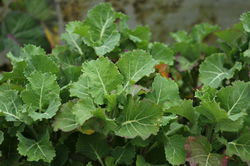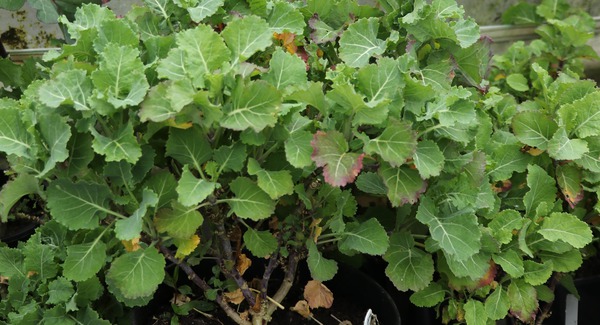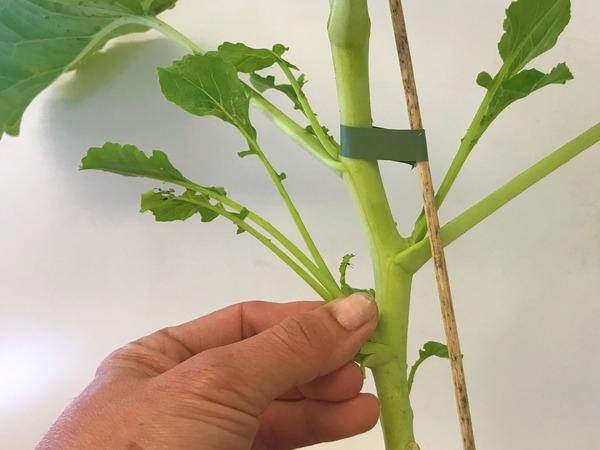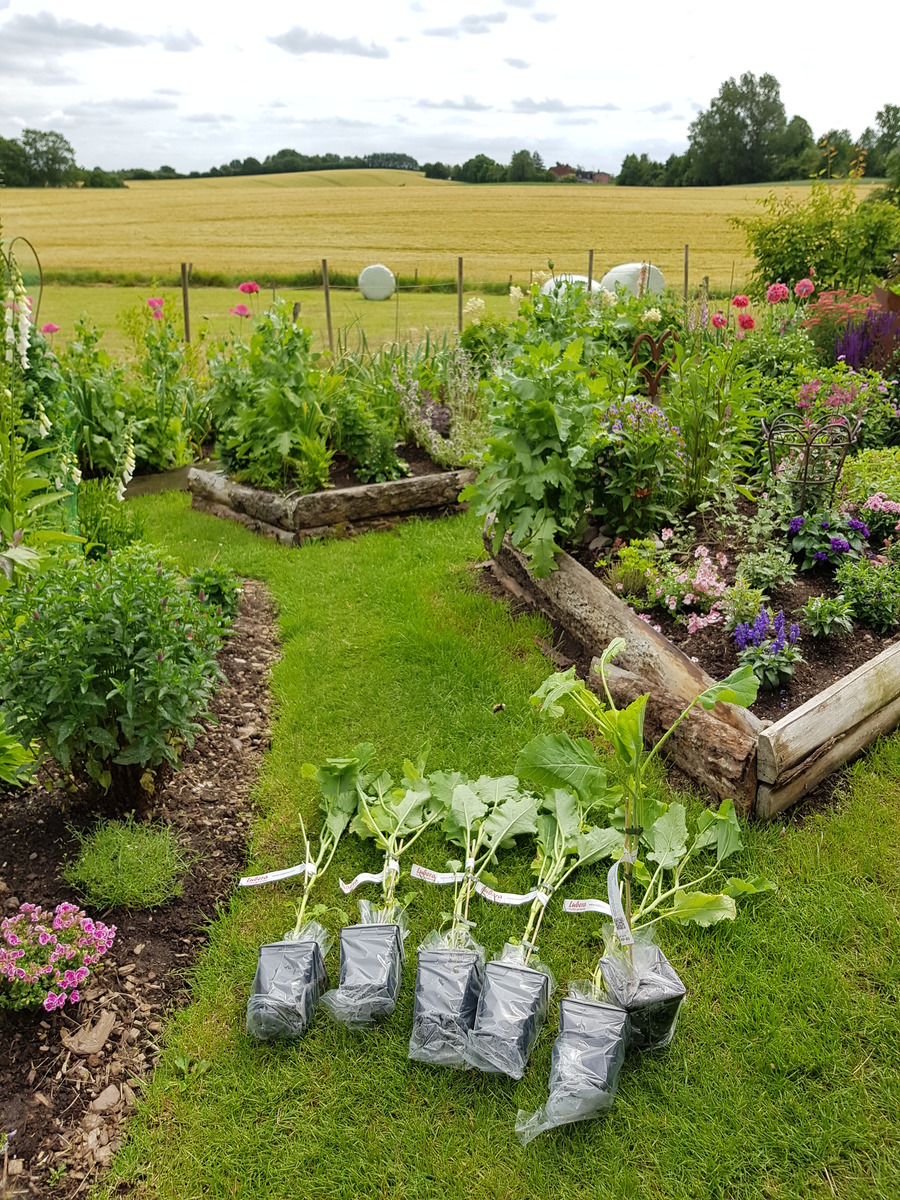 Tree kale (Brassica oleracea var. ramosa, which is sometimes also known as 'perpetual kale”, is an old cultivated plant and makes a harvest of fresh cabbage leaves possible for an entire year, without that constantly new cabbage young plants must be planted. The names perpetual kale and tree kale are already quite accurate and descriptive as far as the growth character and endurance of this particular vegetable are concerned. In the following, we would like to introduce you to this incredible cabbage. From now on we also offer tree kale young plants, which can be cultivated into strong young plants ready for sale from March onwards. And already from the summer of the same year, the harvest can begin at the hobby gardener.
Tree kale (Brassica oleracea var. ramosa, which is sometimes also known as 'perpetual kale”, is an old cultivated plant and makes a harvest of fresh cabbage leaves possible for an entire year, without that constantly new cabbage young plants must be planted. The names perpetual kale and tree kale are already quite accurate and descriptive as far as the growth character and endurance of this particular vegetable are concerned. In the following, we would like to introduce you to this incredible cabbage. From now on we also offer tree kale young plants, which can be cultivated into strong young plants ready for sale from March onwards. And already from the summer of the same year, the harvest can begin at the hobby gardener.
The growth of tree kale
Brassica oleracea var. ramosa is also called perpetual kale, thousand-head kale or branching cabbage. But no matter what you call it in the end, the sum of the synonyms describes this unusual cabbage species quite impressively: tree kale is a perennial and can grow like a tree, as the name suggests; the plants also get multiple shoots when pruned. By not flowering – yes, you read that right, tree kale does not form flowers even after several years – tree kale forms a new shoot at each eye and can thus become a real monster in the garden over time. To keep this plant in check, nothing helps but to harvest and eat. Or, if necessary, you can courageously use pruning shears.

Picture: the shrubby and well-branched growth is easy to recognise
Where does tree kale come from?
The exact original origin of tree kale is not conclusively clarified until today. Sometimes it is said that this type of cabbage comes from the British Isles, then again it comes from the Channel Islands (which is almost the same thing). Another time it is said that tree kale comes from France – given the variety designation of the varieties we offer, this cannot be completely ruled out either. The origin is also sometimes assumed to be on the African continent. As is so often the case, the truth lies somewhere in between and everyone is at least a little bit right with their personal version.
The perenniality of tree kale
What is indisputable however, are the possibilities of using tree kale. Once planted, the hobby gardener and plant enthusiast can look forward to harvesting tree kale at least five years in a row without having to plant new young plants every spring. The perenniality of tree kale is based on the absence of flowering and the relative frost hardiness of the forming stem/basal structure. In this case, the tissue does not get woody from the beginning, but only gradually. The varieties of tree kale we offer can tolerate winter low temperatures down to -10°C to -15°C quite easily, so in particularly severe winters, some protection is definitely advisable.
Harvest and use
Only the leaves are harvested from the tree cabbage; the stems are completely unsuitable for this, as they become too hard and woody over time. And flowers are not formed anyway. Depending on the size and age of the leaves, they can be processed differently. The young, fresh leaves – with their extremely fine cabbage aroma – are very suitable for eating raw in salads or 'green smoothies'. The medium-sized leaves then have a certain spiciness in addition to the typical but mild cabbage aroma. Especially in late autumn and winter, the leaves get a particularly fine sweetness due to the influence of frost. Basically, it should be said that tree kale can be used in the kitchen like any other cabbage.

Picture: Harvesting the leaves of a side bud and simultaneous pricking out the tree kale
Tree kale – the ideal vegetable plant for the garden
But where is the place in the garden for the tree kale and how can it be used? The universal and informal applicability in the garden is the decisive plus point of this rediscovered tree kale – it can be intensively used as a row in the vegetable garden, as a border for beds or even gardens, as a summer-green and also overwintering structure in a mixed perennial bed, between berry plants, or in a herb island that is near a kitchen. Tree kale is the ideal vegetable plant for every garden. Due to its perennial nature and tree/shrub-like, but also somewhat mysterious growth character, tree kale also works very well as a structure-giving and exciting plant in an informal planting in an ornamental garden.
And last but not least: like every plant species in the group of Eternal Vegetables®, the tree kale also convinces by its ability to form a continuous yield of tasty and healthy cabbage leaves over years.

Picture: vigorous tree kale plants ready for planting
The advantages of tree kale
Here are the advantages summarised again in key points:
- Suitable for intensive and passive cultivation (intensive use and care vs. extensive use)
- Attractive and form-giving plant, depending on the variety with different leaf colouration
- High ornamental value, therefore also possible to use in ornamental gardens
- Same use of leaves as with other cabbage varieties
- High growth rate due to the lack of flowering
- Plant only once but harvest at least five years
Tree kale – tips & tricks for the end consumer
So that the end consumer can enjoy tree kale for several years, there are the following points to consider, especially when planting and then in the first years:
- Plant deep: when planting, make sure that in addition to the root ball, up to four nodes are covered by soil. This will result in a more developed root system and the plant will have a greater potential to sprout from the base even after it severely freezes back
- If planting in the second half of the summer, winter protection is essential
- During the first two winters, the root zone and shoot base should be protected from excessive frost (leaves, straw, etc.)
- Beware of mice, as these small rodents are sometimes real gourmets and can cause considerable damage to the cabbage
- From the second year at the latest, the tree kale should be staked; however, you can also do without it, but then after 2-5 years it is to be expected that the heavy cabbage trees fall over...this is also not too bad because they will take root again and start to grow upwards yet another time. This results in an extensive, self-renewing planting, quite comparable with the walking onion (Allium proliferum cepa)
Garden trends and perennial vegetables – tree kale
The advantages of tree kale for the amateur gardener are clear: ornamental and useful, exciting, rarely seen plants, perennial growth. Tree kale, together with the other perennial vegetables in the garden, allows a new way of growing vegetables: without haste and stress, still getting the young plants into the ground in the spring despite work and family obligations. You can use perennial vegetables intensively or very extensively, depending on your mood.

Picture: well grown and sellable tree kale plant in C1,3
Of course, among gardening enthusiasts there are heavy users: the specialists. But the biggest group, especially among new younger gardeners, engages in gardening as an important sideline (among many other things). The garden should be exciting and varied, it should be usable and beautiful, it should give rise to interesting discussions, it should fuel the creative, yet natural cuisine – but a garden should also simply function. These multifunctional and quite high demands (with limited time investment at the same time) are much better met by perennial vegetable plants than annual plants and in addition, these vegetable crops can be planted in sets.
Tree kale and perennial vegetables in the vegetable assortment
Take advantage of the range of young plants with perennial vegetable plants from Lubera Edibles in order to enrich your vegetable assortment and that of your customers and resellers. It seems important to us to combine several perennial vegetable plants with the tree kale, if possible, in order to give the end consumers a choice and at the same time to encourage them to see this old/new vegetable plant group (simple, perennial, enjoyable and beautiful) as a holistic offer.
Please read the following article about the production of our range of cabbage young plants.
